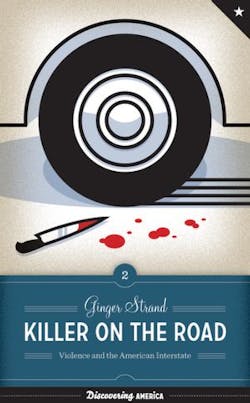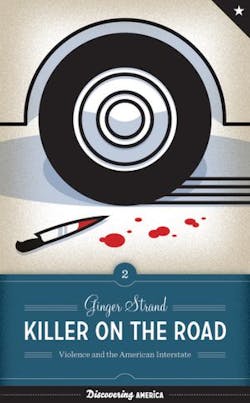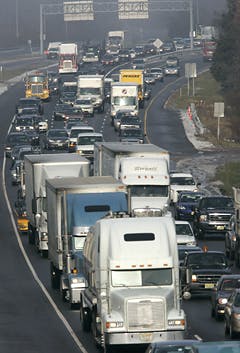Truckers are killers, truck stops are murder zones
Then maybe you too will have problems with one of the central themes of Killer on the Road: Violence and the American Interstate, a book that purports to be an “analysis” of how America’s highway system and – by extension – the trucking industry are helping “breed” serial killers, with truck stops serving as patches of “blight” that do nothing but help foment further evil.
Now, I haven’t sat down and leafed through Killers yet – authored by self-styled environmental writer Ginger Strand – as of yet, but I’m not sure I really want to, for this is the kind of book that seems to have an agenda within its pages detailing the terrible lives of truck stop prostitutes – known in the industry as “lot lizards” – and of serial killers who sometimes (and I stress “sometimes” here) masqueraded as truck drivers to commit heinous crimes.
I mean, how else do you describe an author’s attempt to lay partial blame for the serial killings committed by Wayne Williams in Atlanta back in the 1970s and 1980s on the highway system? Indeed, Strand claims in her book that “Atlanta’s urban renewal and expressway construction had, at the very least, built the stage on which the tragedy in Atlanta could unfold,” going further to quote the National Urban League that these were “white men’s roads going through black men’s bedrooms.”
REALLY? Gee, and the reason serial killings of such magnitude have NOT occurred in Atlanta in last THIRTY YEARS is … they REMOVED the highways? Wait, they are still there. Oh, wait again: they added MORE roads for the 1996 Summer Olympics – guess that fostered a huge outbreak of serial murder. What, they DIDN’T? Hmmmm: I wonder if there’s a problem with this theory.
[Let’s not forget, either, that truckers are trying to fight many of the very evils Strand details in her book – especially sex trafficking. Of course, the efforts of groups such as Truckers Against Trafficking (TAT) garner no mention within its pages.]
Then there’s another artful conclusion that trucking-related serial murders and other violent misdeeds are on the rise in part due to falling union membership.
Really? I mean, one of the worst serial killers in U.S. history – Gary Ridgway, the infamous “Green River Killer” – held union membership as a production line worker, as a truck painter. Does this mean anyone who paints cars or trucks in a factory should be suspected of harboring murderous intent? I don’t think so.OK, yes, I am being extremely sarcastic here – and no, I am not trying to deny the awful fact that, yes, more than a few serial killers (and serial rapists, along with other criminal types) found driving a commercial vehicle to be an excellent cover for committing all sorts of sordid atrocities.
And, yes, the Federal Bureau of Investigation (FBI) is specifically researching serial killings and other violent crime tied to the highway network – an effort launched three years ago via its Highway Serial Killings initiative.
But I’m sorry: we just can’t make this huge leap in logic Strand is proposing in her book.
Look at the FBI’s own data about overall violent crime rates – which in include murder and rape. In 2010, an estimated 1,246,248 violent crimes occurred nationwide, a decrease of 6% percent from the 2009 and – when considering five and 10-year trends – some 13.2% below the 2006 level and 13.4% below the 2001 level.
Now look at the FBI’s most recent violent crime data from last year:
- All four offenses in the violent crime category—murder and non-negligent (read as “willful”)homicide, forcible rape, robbery, and aggravated assault—decreased when data from the first six months of 2011 and the first six months of 2010 were compared. The number of murders declined 5.7%, and the number of rapes decreased 5.1%. Robbery declined 7.7%, and aggravated assault decreased 5.9%.
- Law enforcement agencies in all six city population groups reported decreases in violent crime. Cities with populations of 50,000 to 99,999 inhabitants recorded the largest decrease in violent crime at 7.2 percent. Violent crime also declined in metropolitan counties (7.6%) and in nonmetropolitan counties (6.4%).
- Violent crime declined in each of the nation’s four regions. The largest decrease (9.7%) was in the Midwest, followed by 6.6% in the West, 5.8% in the South, and 3.6% in the Northeast.
Again: REALLY? I’ve been to a lot of truck stops – Pilot, Travel Centers of America, Petro Stopping Centers, and independent firms too like the Trailways Truckstop on Route 301 in Delaware – and not only are most far from “dingy,” they cater to all manner of highway users; families on vacation as well as truckers.
Are a few run down at the heels or in high crime locations? Sure – but you can say that about almost any national chain of businesses, from fast food joints to convenience stores.
Take all of this a step further when we discuss investing in infrastructure. Building highways creates jobs, improves the flow of trade, and helps to link our nation together. Shall we scuttle all such construction because sometimes a serial murder moves along them?
Following Strand’s logic, any effort to build more highways would be tantamount to aiding and abetting murder. Are we going to prosecute Transportation Secretary Ray LaHood for doling out TIIGER grants for roadway construction? Thus you see the implicit problem here.
And of course completely unmentioned in Stand’s compendium of woe is that the U.S. highway system and the trucks that ply it are one of the foundations upon which modern American life is built. Indeed, trucks carry between 70% and 80% of all the freight in this country.
Take them all away, and everything we take for granted – fresh food at the local grocery store, medical supplies at the hospitals, clothes at the department store - all goes away too.
No one seems to get that at all anymore.



